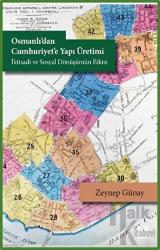An Ottoman Armenian Orphanage: The Short History of Darüleytam-ı Osmânî in Adana(1909-1918)

This book examines the rich history of Dârüleytâm-ı Osmânî, a state orphanage established in Adana by Cemal Pasha of the Adana Governor of the period for Armenian girls and boys who were orphaned due to the Adana massacres of 1909. This orphanage, whose foundations were laid in 1909, was officially opened in 1911 for the education and care of hundreds of orphaned Armenian children. Shortly after its opening, Muslim orphans were also placed in the orphanage and thus became a multireligious and multicultural institution. This study tries to show the views of local officials, Ottoman Armenians, and the Committee of Union and Progress towards the opening of the orphanage by emphasizing the historical role of the Armenian orphans. While drawing a comprehensive political and social picture of the process providing the establishment of the orphanage from 1909 to 1911, I argue that this orphanage was founded for political reasons rather than humanitarian concerns. In this context, the study shows the partnerships, disputes, and conflicts between different groups through the discussions on the administration and control of the orphanage from 1912 to 1914. In addition, I examine the educational, structural and administrative changes and regulations in the orphanage in the 1914-1918 period in the light of economic, political and social events, especially the deportation of Ottoman Armenians. The majority of primary sources used in this book consist of Ottoman archival documents. Besides, missionary and consul reports, memoirs, newspapers, provincial budgets and regulations were also used.
- Açıklama
This book examines the rich history of Dârüleytâm-ı Osmânî, a state orphanage established in Adana by Cemal Pasha of the Adana Governor of the period for Armenian girls and boys who were orphaned due to the Adana massacres of 1909. This orphanage, whose foundations were laid in 1909, was officially opened in 1911 for the education and care of hundreds of orphaned Armenian children. Shortly after its opening, Muslim orphans were also placed in the orphanage and thus became a multireligious and multicultural institution. This study tries to show the views of local officials, Ottoman Armenians, and the Committee of Union and Progress towards the opening of the orphanage by emphasizing the historical role of the Armenian orphans. While drawing a comprehensive political and social picture of the process providing the establishment of the orphanage from 1909 to 1911, I argue that this orphanage was founded for political reasons rather than humanitarian concerns. In this context, the study shows the partnerships, disputes, and conflicts between different groups through the discussions on the administration and control of the orphanage from 1912 to 1914. In addition, I examine the educational, structural and administrative changes and regulations in the orphanage in the 1914-1918 period in the light of economic, political and social events, especially the deportation of Ottoman Armenians. The majority of primary sources used in this book consist of Ottoman archival documents. Besides, missionary and consul reports, memoirs, newspapers, provincial budgets and regulations were also used.
- Taksit Seçenekleri
- Axess KartlarTaksit SayısıTaksit tutarıGenel ToplamTek Çekim332,00332,002172,64345,283117,31351,92659,76358,56940,58365,20Finansbank KartlarıTaksit SayısıTaksit tutarıGenel ToplamTek Çekim332,00332,002172,64345,283117,31351,92659,76358,56940,58365,20Bonus KartlarTaksit SayısıTaksit tutarıGenel ToplamTek Çekim332,00332,002172,64345,283117,31351,92659,76358,56940,58365,20Paraf KartlarTaksit SayısıTaksit tutarıGenel ToplamTek Çekim332,00332,002172,64345,283117,31351,92659,76358,56940,58365,20Maximum KartlarTaksit SayısıTaksit tutarıGenel ToplamTek Çekim332,00332,002172,64345,283117,31351,92659,76358,56940,58365,20World KartlarTaksit SayısıTaksit tutarıGenel ToplamTek Çekim332,00332,002172,64345,283117,31351,92659,76358,56940,58365,20Diğer KartlarTaksit SayısıTaksit tutarıGenel ToplamTek Çekim332,00332,002--3--6--9--
- Yorumlar
- Yorum yazBu kitabı henüz kimse eleştirmemiş.
- Yayınevinin Diğer Kitapları
- Yazarın Diğer Kitapları




















